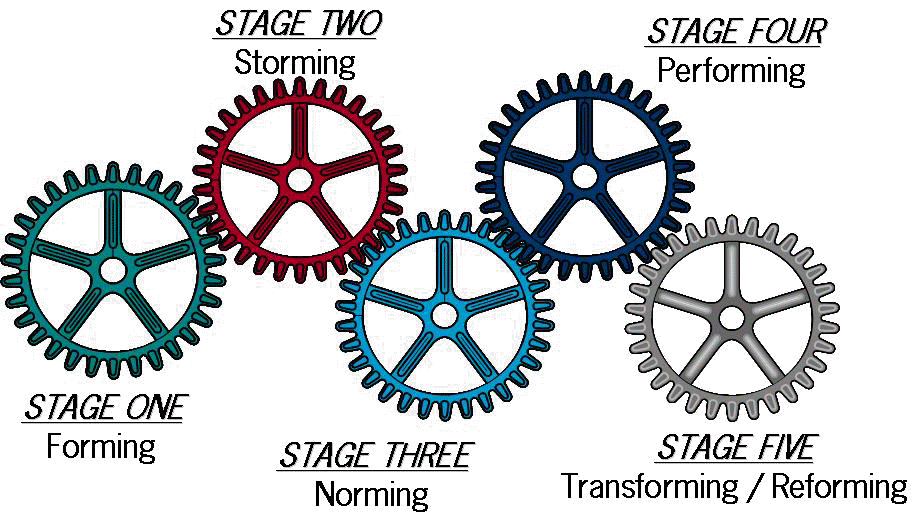THE TOOLKIT
Tuckman Model (Bruce Tuckman)
Teams are put together and develop. Sometimes this experience occurs organically, and it figures itself out. However, most of the time, there are some “growing pains” along the way. Either way, all teams experience a similar process as they move to productivity and effectiveness. Bruce Tuckman developed the five stages (originally four) of team development to show that conflict occurs; it must occur. This happens so that people are able to figure out the “rule of engagement” and progress to a point of high performance.
The five stages, listed below, directly impact one another as represented by the rotating gear shifts. One stage turns or cranks another. As such, if one gear gets stuck, then so does the team. The five stages are depicted below.

Stage One – Forming
The team forms. The players are assembled. Usually this stage is thought of as the “honeymoon” where everyone is very respectful and cordial with one another. It’s as if you are on a first date and as such, on your best behavior.
Stage Two – Storming
As with most honeymoons, they are short-lived. Conflict occurs. Boundaries develop. People are trying to understand their role and hence the value they bring to the team. In doing so, team players tend to experience miscommunication, misunderstanding, and missed opportunities. The only way to manager through this stage is to communicate… communicate… communicate. Err on the side of over-communication. Get to a point where the team is setting processes and procedures to manage the communication flow.
Stage Three – Norming
Processes and procedures are developed. Rules and guidelines are agreed upon. In this stage, team members develop SOPs (standard operating procedures) and more importantly, rules of engagement regarding how people will interact with one another including meetings, brainstorming, problem-solving, decision-making, etc.
Stage Four – Performing
Finally, we get to a point where as a team we are able to accomplish the goals for which we were assembled. We produce high quality results. We meet and exceed expectations. At times, it may even seem as if we are reading each others’ minds because we have become so in tuned with one another.
Stage Five – Transforming/Adjourning/Reforming
As is with everything else in business, things change. Teams change. Either the team continues to grow and takes on more more responsibilities, so the players must transform their operations and interactions. Or, the team accomplishes its goal and is disbanded. Or, the team requires more resources and more people and must reform to meet the individual needs and style nuances of these players as well. As such, we begin anew and move to the first gear, forming.
However, ideally we’ve learned enough from previous experiences through the gears that we can crank them a bit smarter and faster.



